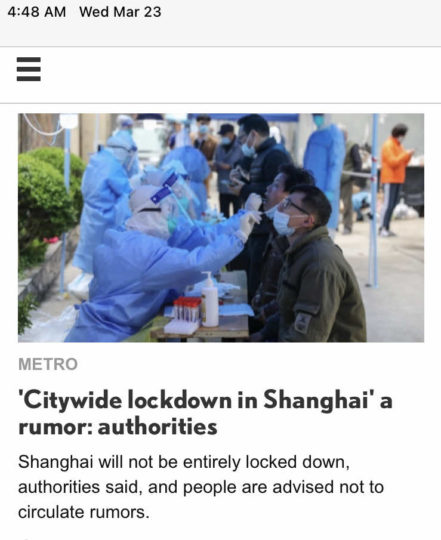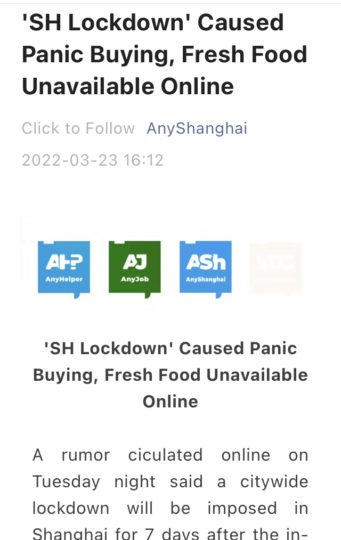
When the number of daily cases in the United States continues to hover around 27,000, the number 52 seems meaninglessly small. It’s a rounding error, not even worth thinking about. But if your goal is zero, then 52 is a very large number. It’s a very large problem.
China is persistently sticking to its policy of completely eradicating the COVID virus. Their goal is zero cases. In Chinese, there is a new meaning of the word “reset” 清零. The original meaning, returning a computer to factory settings, now means that an area has been completely cleansed of COVID cases. If you had cases in your neighborhood, but through quarantine and isolation, you no longer have cases, then your area has been “reset.” Although they’ve since refined the term to match their more targeted, granular approach, the ultimate goal has not changed: China will completely eradicate the COVID virus from every corner of the country.
To people with the attitude that the only option is complete and total “victory,” the west’s co-existence strategy looks like giving up. The United States and other western countries have lost their resolve, and have callously decided that the lives of thousands of people is a price worth paying in order to preserve the economy. In contrast, the Chinese government insists that they will not surrender, vowing to continue fighting until they achieve complete victory. Failure is not an option, and everyone is expected to get in line and join in the fight. Alternative approaches are not only unwelcome, but voicing them can lead to censure or worse.
If the military metaphor is obvious to you, it’s because that is the tone that the authorities continually take. Couching social programs in military terms is commonplace here, and the pandemic The Chinese term for “counter-pandemic” is a homonym for “war of resistance” in Chinese.
The “reset” approach actually worked pretty well to control the virus two years ago. COVID version 1.0 wasn’t as contagious. Early detection and isolation were effective in stopping the spread.
Then the variants arrived. The U.S. and other countries were ravaged by the Omicron variant several months ago, and now Omicron has finally arrived in China. The virus changed. The Chinese government’s posture hasn’t.
Several cities, and one entire province, were “locked down” for weeks starting in late 2021, when the virus started getting out of control. Again, the numbers were relatively low, especially when compared to the experience of the United States. We wouldn’t blink if the state of Indiana had 1,500 new cases in one day. But numbers like that were large enough for the Chinese government to take drastic action.
And when the numbers in Shanghai started growing, the rumors grew as well. The city government insisted that they had it under control, they didn’t need to shut down the city. I think people wanted to believe that, but couldn’t.

Cases continued to grow, and people got more and more nervous. Last week, as we were going to work in the morning, the subway station was eerily quiet. People weren’t taking the subway for fear of getting tagged as a “close contact” and hauled off to a quarantine center.

Panic buying of food (not toilet paper). We had been advised a long time ago to have two weeks’ worth of food on-hand, so our pantry was pretty well stocked.

Still, the government denied that a lockdown was coming. The narrative was that the city, as the financial heart center of the country, the most modern city in China, the “magic city” was somehow different. To use a term from a decade ago, Shanghai was too big to fail.

The day after this story came out, we had this announcement. Shanghai would lock down in two steps.

Not an April Fool’s joke, our lockdown started on Friday the 1st. Our apartment building told us that we were confined to our apartments. And that’s where we are now. We can only leave the apartment when we are shepherded to the testing centers.


We were herded to the testing center on Friday morning.


Everyone has to register their cell phones with the government. All of our health information is in the cloud, and must be presented on-demand, usually when we enter office buildings and shopping centers.

In theory, the lockdown of this half of the city will last for four days, until April 5. I suspect that few people believe that. The other half of the city, which began lockdown last week, was scheduled to be opened back up two hours after our lockdown began. It is still locked down.

So, we wait. We have plenty of food. Our pantry is well-stocked, but our refrigerator is pretty small. We’re storing some vegetables in a bathroom sink.

While we are locked down, we can’t go to the office. We can’t hold our programs. We can’t with our counterparts in the local government. No one can say how long this will last. I’m not diplomatting, and I hate that.